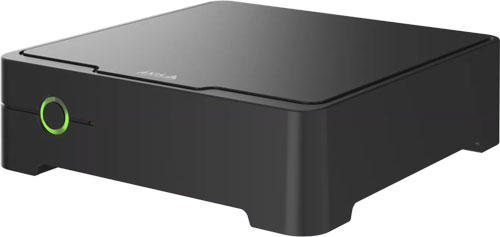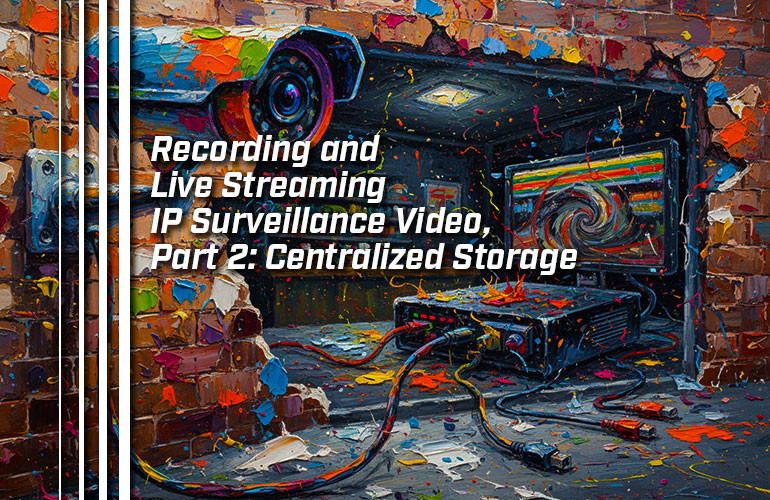This post is the second part of a three-part series on recording and live streaming surveillance video from IP cameras. It covers centralized storage. The first part on edge storage for IP cameras is available now, and the third part on live streaming will be published next week.

In our last blog, we introduced edge storage in IP cameras using SD cards. That’s not the only option you have for storage.
In this blog, we introduce the three options you have for storing surveillance video in a centralized location: NVR, local hard drive or NAS, and cloud.
Let’s get into it!

Centralized Storage for IP Surveillance Video
Storing video on the edge is great, but what about storing video that’s transferred through the network from the camera to a centralized storage solution?
There are three options for centralized IP camera video storage:
- Network video recorder (NVR)
- Local hard drive or network-attached storage (NAS) system
- Cloud storage
The three options provide similar basic advantages, but there are reasons people choose one over the others or use more than one in tandem. We’re going to introduce each option, then discuss features to look for when deciding between the options.
First, let’s cover the advantages of centralized storage over edge storage. These benefits are common to all three options:
- Centralization
- Expanded storage capacity
- VMS integration
Centralized storage is, well, centralized. With edge storage, each camera holds its own video on an SD card. With centralized storage, all recorded video from every camera is accessible.
You can also store much, much more video with centralized storage. While 1 TB microSD cards are common, hard drives can hold vastly more. Plus, most storage devices are scalable, so if you require more storage, you can add more. By storing more video, you get a more complete archive of video evidence.
With IP cameras, storage and system management are integrated. It may be that you run the video management software (VMS) on a computer with attached storage, or you run the VMS directly on the appliance that records the video.
In either case, centralized storage is an integrated solution that lets you adjust cameras, view feeds, go through recorded video, and so on.

Network Video Recorders (NVR)
Network video recorders are dedicated appliances for recording surveillance video from IP cameras. You can think of an NVR as a purpose-built computer for running the VMS software and recording video.
The primary advantage of an NVR is simplicity. If you’re an SMB owner looking for a fast, professional solution for video surveillance, an NVR is definitely the way to go. In fact, even quite large camera installations are covered by NVRs.
An NVR is an out-of-the-box solution. You don’t need to worry about making sure your computer has the correct specs and so on. It will have internal components that provide optimal performance.
Most NVRs come with VMS software pre-loaded, and many come with VMS licenses for a certain number of camera channels. Many support expandable storage and additional licenses for more channels. Surveillance-grade cybersecurity is a given. If you use IP cameras from the same brand as the NVR, you have a single-brand solution that guarantees compatibility and performance.
Many NVRs are also PoE switches. A Power Over Ethernet switch is a network switch that can deliver power to a connected endpoint through a standard Ethernet cable. Virtually all IP cameras support PoE, so an NVR with an integrated PoE switch is a dual solution: it connects the camera to the network and powers it at the same time. If you’d like to know more about Power Over Ethernet, check out our blog, “The Ultimate Guide to Using PoE (Power Over Ethernet) to Power IP Devices.”
They’re very good solutions, but they’re not the only solutions.
In this case, you can use your own computer and your own hard drive.
Local Hard Drive and Network-Attached Storage
You can run VMS software on your own computer and servers, in which case you would be recording video to a local hard drive and to external storage.
This arrangement enables maximum flexibility while letting you have total control. It can handle any size of camera system and can be scaled to meet your needs.
Unfortunately, it also requires more technical know-how, because it’s not an out-of-the-box solution like an NVR. You must make sure your computer has the proper operating system (OS) and specs to be compatible with and run the VMS software. You will need a server to handle network connectivity for the cameras.
And you will also need to ensure you have enough storage capacity. That means, probably, a local hard drive plus external storage for smaller installations, and a NAS for larger installations.
Network-attached storage (NAS) is a common external storage solution. Think of NAS as a local server dedicated to file management. It offloads storage and centralizes data sharing. It not only provides maximum storage capacity but also acts as a shared hard drive. For mission-critical surveillance, it can also be arranged to provide redundant storage, so if one hard drive fails, you have a backup ready to go.
One of the main drawbacks of a NAS system is increased complexity — they aren’t easy for people without technical know-how to setup and manage. NAS systems are also normally slower than an NVR or local hard drive, which means writing to memory could take longer and performance could be decreased.
Both NVRs and NAS systems are local storage options. Local storage, however, isn’t the only way to go.
The third method of video storage for IP cameras is cloud storage.
Cloud-Based Surveillance Video Storage
Cloud storage is a subscription-based solution for having your data securely stored on another company’s servers. Cloud storage for IP cameras is, in essence, no different than storing your work documents, spreadsheets, and pictures on Microsoft OneDrive, Google Drive, Apple iCloud, Dropbox, and so on.
With cloud-based storage, you no longer need to purchase and operate a recording device yourself. That makes cloud storage a simple option — very attractive for small-scale camera systems.
It also is an excellent option for redundancy. In this case, you would have your own local recorders and have backups in the cloud in case something goes wrong.
It’s a great option, but there are a few drawbacks. First, you must pay a subscription license — ongoing costs. The subscription might cap video resolution and other features unless you pay for a higher tier.
Also, you don’t control the machines that store your video. For data as sensitive as video surveillance feeds, that might be a concern.
These are your three storage options. What features should you look for?
Features to Look for with Centralized Surveillance Video Storage
With all three solutions — NVR, hard drive or NAS, and cloud — there is a common set of features that you should look for when considering which solution to go with:
- VMS compatibility
- Required specs
- Expandable storage
- Channels and licenses
- Feature support
- Video resolution support
- Advanced video codec support
- Video feed efficiency technologies
- Integrated PoE switch
- Security features
Like all software, video management software (VMS) is only compatible with certain operating systems and endpoints. Before purchase, always triple-check compatibility. You don’t want to buy four IP cameras that don’t end up working with your management software.
There is a set of open standards known as ONVIF that guarantees interoperability of certain features, so you can, for example, use an IP camera from Brand X with a network video recorder from Brand Y if they’re both ONVIF compliant. It’s like how Open SIP phones from one brand are interoperable with SIP-based VoIP phone systems from another brand. But we reiterate: check compatibility before purchase!
VMS has hardware requirements, just like any other computer program. If you’re opting to run the VMS on your own computer, make sure your computer can handle it.
You also need to make sure your network can handle the traffic, especially if you want high-resolution video like 4K Ultra HD surveillance video. High-res video can take up a lot of bandwidth and storage space. Make sure to check network throughput and storage memory writing speed: do they match the requirements?
We recommend you find a solution that offers expandable storage, so you can have a longer archive and scale your camera system without worrying about how the new load will affect your system.
Each camera feed in an IP surveillance system is a channel. Whatever recording solution you use, you need to make sure it supports the requisite number of video channels. This might require buying licenses for additional channels.
Licenses, or upgraded licenses, might also be necessary to unlock specific features. When budgeting for a camera system, always incorporate the necessary licenses into your plan.
IP cameras are capable of so much more than traditional CCTV cameras. AI features are rolling out across the industry, too. These features can greatly enhance the usability of your surveillance video. As an example, check out our blog, “How Metadata Makes Your Surveillance Video More Effective.” Make sure your VMS and recording solution works with the features you want to use.
Also make sure your recorder and network can handle video of your desired resolution. For example, you might want 4K Ultra HD video for surveillance of an open plaza in a city, so you have sufficient detail even for such a wide-angle shot. However, can your recorder handle the intense bandwidth and large file-size of 4K Ultra HD video? Make sure your system can store high-resolution video if you require it.
To save on bandwidth and storage load, look for solutions that support advanced video codecs, in particular H.265 (HEVC) and AV1. They can reduce file size by huge amounts. These codecs must be supported by both camera and recorder. If you want to know more about AV1, check out our blog, “What Does the AV1 Video Codec Mean for Business?”
Related to video codecs are what you might call video feed efficiency technologies. Take Axis Zipstream. This technology maintains full detail only on important sections, so, for example, the camera isn’t sending full resolution videos of an unchanging wall or the sky that happen to be in the shot. The video feed is made much more efficient this way. Does your system support a feature like that?
You need to power the cameras. Most IP cameras are designed to be powered via PoE (Power Over Ethernet). Many NVRs double as PoE switches, so they connect the cameras and power them at the same time. If you don’t have one of those, you’ll need to make sure you have a compatible PoE solution for your IP camera system.
Finally, go over the cybersecurity features with a fine-toothed comb, particularly if you’re dealing with cloud-based services. Do they meet professional standards? Will your sensitive video be secure?

